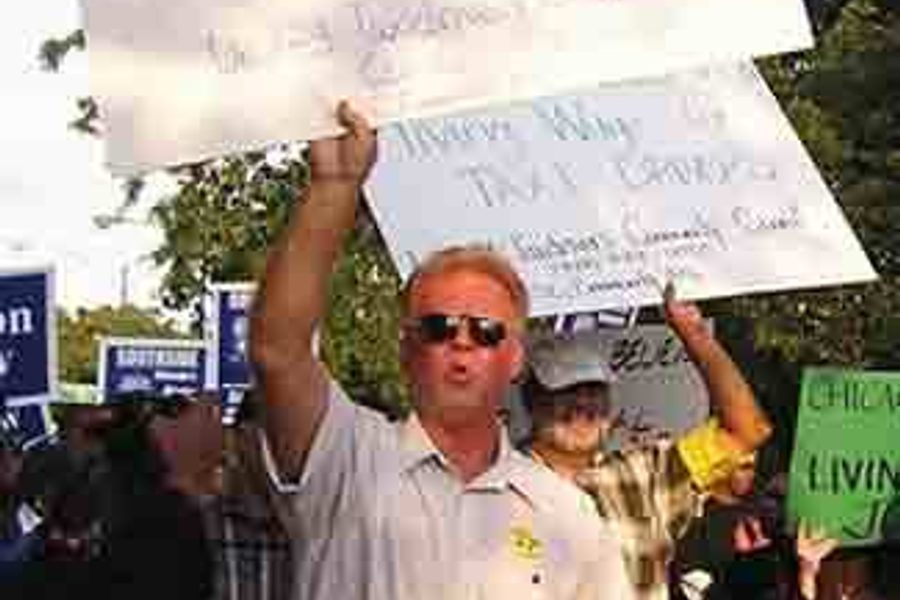
Cab drivers earn as little as $4 an hour, regularly work 12-hour days six days a week, suffer debilitating work-related health problems and are mistreated and gouged by customers, city regulators and leasing companies. Yet most feel such a sense of pride and community in the occupation that they don’t even consider switching professions.
This was among the revelations at the United Association of Labor Education’s annual conference in San Diego last week, where Chicago professor Robert Bruno and east coast public health specialist Rebecca Reindel discussed their research in an increasingly high-profile field of study: cab drivers’ working conditions and organizing drives.
Bruno, whose work I’ve blogged about here before, has studied various facets of cab drivers’ daily lives, including wages and hours, frequency of violence and treatment by city regulators and leasing companies. He found that Chicago cab drivers on average earn only $4.38 an hour, often working almost 12 hours just to cover their lease and making a profit at the tail end of long shifts.
Reindel, pursuing a master’s in Public Health at George Washington University, studied occupational health effects on New York City cab drivers, in cooperation with the highly organized and active New York Taxi Workers Alliance. She found that nearly one in two drivers suffers moderate to severe pain each week that could be attributed to their job, with lower back pain not surprisingly being the most common complaint.
She found drivers also report significantly more pain on their right side, perhaps related to constantly twisting to collect fares and talk to passengers.
Reindel and a research partner identified a number of relatively simple and affordable remedies which drivers thought would greatly increase their comfort. The drivers identified safety shields, especially “L-shaped” ones that protrude between the driver and front seat passenger, as impeding their mobility and arm and leg space. Many drivers were unable to adjust their seats at all. In general, she noted that cars should be built as cabs from scratch in order to provide decent ergonomics and safety, as opposed to the usual procedure of retrofitting regular Crown Victorias or other vehicles.
Bruno and Reindel are often asked why, given the low wages, dangerous and grueling working conditions, and other drawbacks, people continue to drive cabs at all. The two researchers note that despite the problems, drivers feel an intense sense of pride in their work and also have tight-knit communities of drivers, especially within their own ethnic group. Groups of drivers from a given country, like Pakistan or Nigeria, are likely to all live in the same apartment building or even share apartments, Reindel noted.
“It’s such a cohesive unit,” she said, having observed the camaraderie and support among drivers during 12-hour ride-alongs. “For example, when they go to the airport it takes longer, they have to wait and they have to pay a tax, but it’s worth it because they like to mingle with their friends.”
More than half the drivers surveyed in Chicago and New York have college degrees, and many have graduate degrees. Though they are usually unable to work in their professional field in the U.S., driving a cab allows people to see themselves more as independent entrepreneurs than wage workers, Bruno notes.
“It’s a mobile sweatshop, but they do feel a pride in the job, and they are so embedded in the city of Chicago, they know the city so well and take pride in that,” said Bruno. “This is seen as much more dignified than working at McDonald’s. They’re businessmen, they have flexibility, though it’s flexibility without control since the city essentially controls them.”
Some drivers do own their own cabs and the medallions that most (though not all) cities require drivers to buy or lease in order to operate legally. But the vast majority of drivers lease cabs and medallions from major companies, or — less frequently — own their own cabs but lease medallions.
At the conference last week, Empire State College Professor Michael Merrill noted that the medallion system was typically a well-intended response to drivers’ own concerns about too many operators flooding the market…but the system in most cities turned into what could be called an exclusive racket controlled largely by just a few families or businessmen in a secretive manner.
Medallions in Chicago cost well over $100,000, and in New York they go for more than half a million dollars, making it extremely difficult for new owner-operators to enter the market and forcing them to work long hours just to pay off loans if they do.
Merrill proposes driving a cab should be a municipal job where workers could be organized by public employees unions and granted solid health benefits and pensions. But because of their independent spirits and negative stereotypes about unions harbored by drivers — perhaps because of experiences in their home countries — many drivers are resistant to these sorts of proposals.
Taxi drivers organizations, like the NYTWA in New York and the United Taxidrivers Community Council in Chicago, are springing up in a growing number of cities and often work together. They have called numerous strikes in recent years, but the nature of the industry is such that a very high percentage of drivers must participate to make a serious impact.
“This shows the difficulty of changing many of these situations,” Merrill said.
Kari Lydersen is a Chicago-based journalist, author and assistant professor at Northwestern University, where she leads the investigative specialization at the Medill School of Journalism, Media, Integrated Marketing Communications. Her books include Mayor 1%: Rahm Emanuel and the Rise of Chicago’s 99%.








